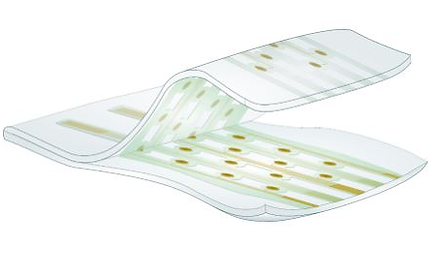
Applications
Biomedical Health Monitoring
Biomedical health monitoring involves the use of sensors to continuously track vital physiological signals—such as heart rate, respiration, blood pressure, and muscle activity—to provide real-time insights into a person's health status. The goal is to move beyond reactive medicine towards a proactive and preventative healthcare model, where subtle changes in physiological data can be detected early to prevent acute events like heart attacks, manage chronic conditions, and optimize personal wellness.

P(VDF-TrFE) Copolymers for Biomedical Applications
Traditional medical sensors are often rigid, bulky, and require adhesives or gels, making them uncomfortable for long-term use. P(VDF-TrFE) polymer sensors, available as thin films or flexible fibers, offer a compelling alternative due to a unique combination of properties.
-
Biocompatibility and Skin-Conformability:
P(VDF-TrFE) is chemically inert and non-toxic, making it safe for prolonged direct contact with human skin. Its inherent flexibility allows the sensor to conform perfectly to the soft, curved surfaces of the body, ensuring high-quality signal acquisition without causing irritation or restricting movement. This makes it ideal for smart textile-based sensors.
-
High Sensitivity to Subtle Physiological Signals:
The human body generates very weak mechanical signals, such as the minute vibrations from a heartbeat or the slight expansion of the chest during breathing. P(VDF-TrFE) has an exceptionally high piezoelectric coefficient, meaning it is extremely efficient at converting these tiny mechanical stresses into a measurable electrical voltage. This high sensitivity is the key of capturing high-fidelity physiological data.
-
Self-Powered Operation:
A key advantage of piezoelectric sensors is their ability to operate without an external power source. They harvest energy directly from the mechanical motions of the body—like walking or breathing—to power themselves and their associated electronics. This is critical for developing long-term wearable or implantable devices where battery replacement is impractical.
-
Versatility in Form Factor:
P(VDF-TrFE) can be processed into various forms, from large-area films to micro/nano-scale fibers. This allows for diverse implementations: thin-film patches that adhere to the skin, fibers that can be woven directly into clothing to create "smart textiles," or miniaturized sensors for integration onto medical instruments like catheters
Application Fields
P(VDF-TrFE) sensors are enabling new ways to monitor a wide range of vital signs.
1. Advanced Cardiovascular Monitoring
Cardiovascular diseases are a leading cause of death, making continuous monitoring a critical tool for early detection and management.
-
Arterial Pulse Wave Analysis: By placing a flexible P(VDF-TrFE) sensor on an arterial point like the wrist, it can precisely capture the arterial pulse wave—the pressure wave generated by each heartbeat as it travels through the arteries. Analysis of this waveform provides rich information beyond just heart rate, including heart rate variability, arterial stiffness, and estimations of blood pressure. Studies have shown that data from these printed sensors correlate strongly with clinical reference devices.
-
Unobtrusive Heart Mechanics (BCG/SCG): Ballistocardiography (BCG) and Seismocardiography (SCG) are non-invasive methods that measure the subtle body vibrations caused by the heart pumping blood. P(VDF-TrFE) sensor arrays can be embedded into a mattress or chair cushion to monitor these signals without any electrodes attached to the person. This is ideal for long-term, comfortable monitoring of cardiac function, especially for elderly patients or during sleep.
2. Continuous Respiratory Monitoring
Monitoring respiration is vital for managing conditions like asthma, COPD, and sleep apnea.
-
Wearable Respiration Sensors: A flexible P(VDF-TrFE) sensor integrated into an adjustable chest belt can accurately track the rate and relative amplitude of breathing by measuring the displacement of the thorax and abdomen.
-
Airflow-Based Monitoring: Alternatively, a small sensor placed near the nostrils can detect the airflow pressure during inhalation and exhalation. This method is highly sensitive and can detect even very weak breaths, making it suitable for identifying events like apnea (a pause in breathing) or hypopnea (shallow breathing) during sleep studies.
3. Muscle Activity and Fatigue Monitoring
For athletes, rehabilitation patients, and individuals with neuromuscular disorders, understanding muscle function is the key.
-
Muscle Patch Sensors: An ultra-compliant patch sensor made from P(VDF-TrFE) fibers can be attached directly to the skin over a muscle. When the muscle contracts, it bulges, stretching the sensor. The sensor's output signal faithfully tracks the muscle's activity, allowing for the differentiation between various types of contractions (e.g., concentric, eccentric, isometric) and the monitoring of fatigue-induced tremors. This provides a richer dataset for performance analysis and rehabilitation tracking than traditional methods.